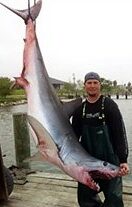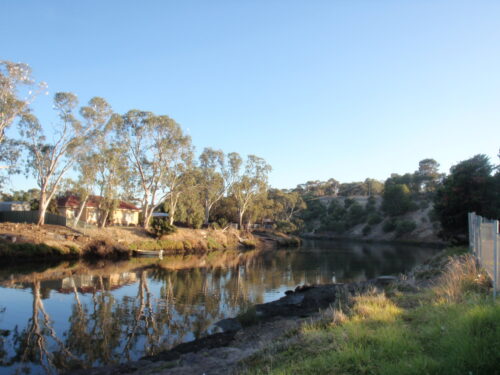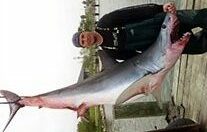Although our recent lock-down has now ended, this is an update to my “Lock-down Story No.4 – My Experiences with Sharks”. In Lock-down Story No.4 – My Experiences with Sharks, I overlooked a story from 1987. I have just rediscovered a report that I made in our April 1987 newsletter (No.117).
My report titled “Sharks” made mention of things such as:
Sharks had been very much in the news during March 1987
Fishermen had been catching a few sharks during this time
Seals had been attacked by sharks
Some boats had also been attacked by sharks
A shark had attacked a surfer on 31st March 1987 (location unknown)
A fisherman at Carrickalinga had flicked a 3m-long shark out of the water by the tail with his bare hands on 15th March 1987
I then proceeded to tell a story about how a fisherman had speared a 2.5m-long blue pointer shark in the Onkaparinga River at Old Noarlunga, 4km upstream from the river mouth at Port Noarlunga. I reported, “It is not rare for sharks to swim into river systems, whether they are saltwater or freshwater. The experts expressed surprise that the blue pointer had swum so far up the Onkaparinga River which is a popular bathing spot for young children.”
I got caught up in this incident. I was shocked at the thought. I suggested, “Hopefully, everyone will be a bit more careful in the river from now on as there is never a guarantee that rivers are shark-free.”
I also reported, “The fisherman who caught the blue pointer believes that there is still another one in the area. The blue pointer, Isurus glaucus, is considered to be savage and dangerous to man. Also known as the Mako, it grows to a length of about 4metres (13 feet) and a weight of 363 kg (800 lbs).”

A captured mako shark
(Photographer unknown)
I had quickly typed up my report on the evening of 31st March, but then I had to do a quick correction the following evening. I must go back to the beginning of the story to explain.
I was working in the office at the Old Noarlunga abattoirs. A call came through to my boss, saying that a shark had been caught nearby in the river. My boss wanted to see it for himself. He took at least 3 more of us in his car to rush down by the river to see the shark.
There was no shark there to see. We were told that the shark had been moved to the pub at Willunga, a good drive away. My boss lived at Willunga, but he couldn’t wait to find out more. Even though we were all supposed to be working, he drove all the way to the Willunga pub to see the shark.
We were told that the shark was out the back of the pub. Sure enough, there was this big mako shark. Amazing! We rushed back to work and reported our adventure to our fellow workers. As I said earlier, I rushed home and typed a report on my antique typewriter.
I don’t have any photos to illustrate this report at all. We didn’t have mobile phones back in 1987 as far as I can recall. I’m guessing, however, that this location on the Onkaparinga River at Old Noarlunga is the spot where we thought that the hoax blue pointer shark had been either speared or landed: –

I was driving in to work the next morning whilst listening to the original SAFM breakfast show on my car radio. As I was approaching work, the show reported that there was a BBQ event being held by the Aldinga (Sharks) Football Club for April Fool’s Day. I knew instantly that I had been conned the day before as part of an April Fools trick.
This was no doubt the discussion of the day at work. I rushed home after work to amend my report by simply adding, “It has since been confessed (and obvious) that the capture of the blue pointer in the Onkaparinga River was a leadup to an elaborate April Fool’s Day hoax by the Aldinga Football Club who are nicknamed The Sharks. The whole incident was rigged to draw attention to the club’s players antics down by the Onkaparinga River on April Fool’s Day.”
I added, “Nevertheless, my warning about the possibility of sharks swimming in any river still stands. It is also a great pity if the blue pointer was killed unnecessarily in preparation for this silly hoax.”
My “Sharks” report also included the following details: –
“Rodney Fox who was attacked and badly mauled by a White Pointer Shark over 23 years ago (in 1963) at Aldinga Beach has spoken in defence of the shark on TV and radio recently. He says that the shark is being killed unnecessarily by fishermen and is fast becoming an endangered species. He asks that all white pointers be left alone. The great White is a slow breeding shark which is being slaughtered faster than it can breed. This will make them shark extinct before we can understand its role in the ecology of the sea. There are very few shark attacks and more people are killed by lightning or bee stings. Of 200 species of sharks in the world, most are harmless and only 10% attack humans. Sharks will go without food for 2-3 weeks but are attracted by fish juices and blood at any time. They are said to frequent beaches inhabited by seals or near effluent outlets or dirty water. They can swim in shallow water and can still occur when dolphins are around as dolphins are a preferred food of the white pointer.”

